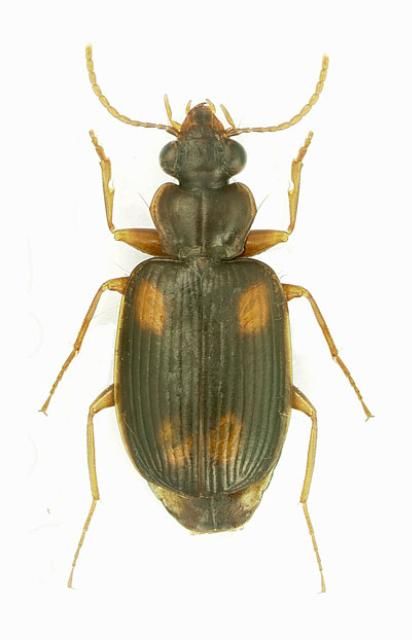The Featured Creatures collection provides in-depth profiles of insects, nematodes, arachnids, and other organisms relevant to Florida. These profiles are intended for the use of interested laypersons with some knowledge of biology as well as academic audiences.
Introduction
Mochtherus tetraspilotus (MacLeay) was first detected in southern Florida in 1992 from two specimens taken at mercury light by Vince Golia in Palm Beach County. These specimens remained unidentified until 1999 when Danny Shpeley, of the University of Alberta, determined them to be Mochtherus. Since then specimens have been collected in Gainesville by Paul Skelley, of the Division of Plant Industry, and Paul Choate, and additional specimens have been seen from light trap samples at Archbold Biological Station in Highlands County.
Description
Length 6 mm to 8 mm. Mochtherus tetraspilotus may be distinguished from other Florida Lebiini by a combination of the following characters: hind tarsomere four is not bilobed; tarsal claws with three teeth, a large outer tooth and two smaller inner teeth; mentum toothed; elytral interval three with two dorsal punctures; each elytron with two yellowish orange spots (Figure 1); labial palpi slender; pronotum setulose (covered with short hairs, which are best viewed with side lighting). The most easily observed character is the presence of two yellowish-orange spots on each elytron. A humeral spot extends from intervals four or five to seven or eight, and a subapical spot covers intervals two to five. No other Florida Lebiini species is known with this coloration and combination of characters. Two genera containing maculate species that might be confused with this species are Plochionus and Pinacodera. However, these genera are separated from Mochtherus by their labrum being distinctly wider than long and their head lacking a long seta posterior to the submentum.

Credit: Michael C. Thomas, Florida Department of Agriculture & Consumer Services
Within Mochtherus only two species have yellow-orange spots, Mochtherus tetraspilotus and Mochtherus longipennis Jedlicka. They may be separated by the following characters: Mochtherus tetraspilotus has pronotum wider than head, oval body shape, with sides rounded; Mochtherus longipennis has pronotum only as wide as head, body elongate, sides parallel (Jedlicka 1963).
Biology and Pest Status
Little is known about the biology of this species. Members of the carabid subtribe Pericalina are known to inhabit the trunks of trees. Darlington (1968) reported a species of Mochtherus in New Guinea as occurring on recently felled logs. In Florida, specimens have been collected on recently felled logs where they actively run about, feeding on small insects. Individuals have also been taken at lights. This species occupies the same habitat as a native carabid species, Coptodera aerata Dejean. The impact of Mochtherus on Coptodera remains unknown.
The pest status of this species is unknown at present. Adult members of this group of Carabidae are known to be predators. The impact of this species on our native species remains to be determined, as does the source of introduction. Its rapid spread in Florida suggests that it may soon be found throughout the Gulf States.
Distribution
The genus Mochtherus is known from Japan, Formosa, Philippines, Borneo, Java, Sumatra, Malaya, Indo-China, Thailand, Burma, Ceylon, India, across the Malay Archipelago, New Guinea, as well as Christmas Island and Samoa. (Habu 1967; Jedlicka 1963; Darlington 1968). Mochtherus tetraspilotus is known from Japan, Burma, Philippines, Laos, Taiwan, Borneo, Java, Ceylon, and India (Jedlicka 1963; Habu 1967). Habu (1967) considered Mochtherus a subgenus of Dolichoctis.
Selected References
Darlington, PJ, Jr. 1968. The carabid beetles of New Guinea Part III. Harpalinae (Continued): Perigonini to Pseudomorphini.Bulletin of the Museum of Comparative Zoology 137: 1–253.
Habu, A. 1967. Fauna Japonica. Carabidae. Truncatipennes Group. (Insecta: Coleoptera). Biogeographical Society of Japan. Tokyo Electrical Engineering College Press, 338 pp.
Jedlicka, A. 1963. Monographie der Truncatipennen aus Ostasien. Lebiinae - Odacanthinae - Brachyninae. (Coleoptera, Carabidae). Entomologische Abhandlungen und Berichte aus dem Staatlichen, Museum für Tierkunde in Dresden 28: 269–368.